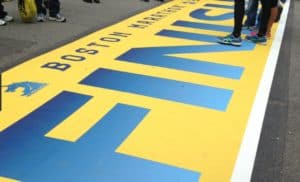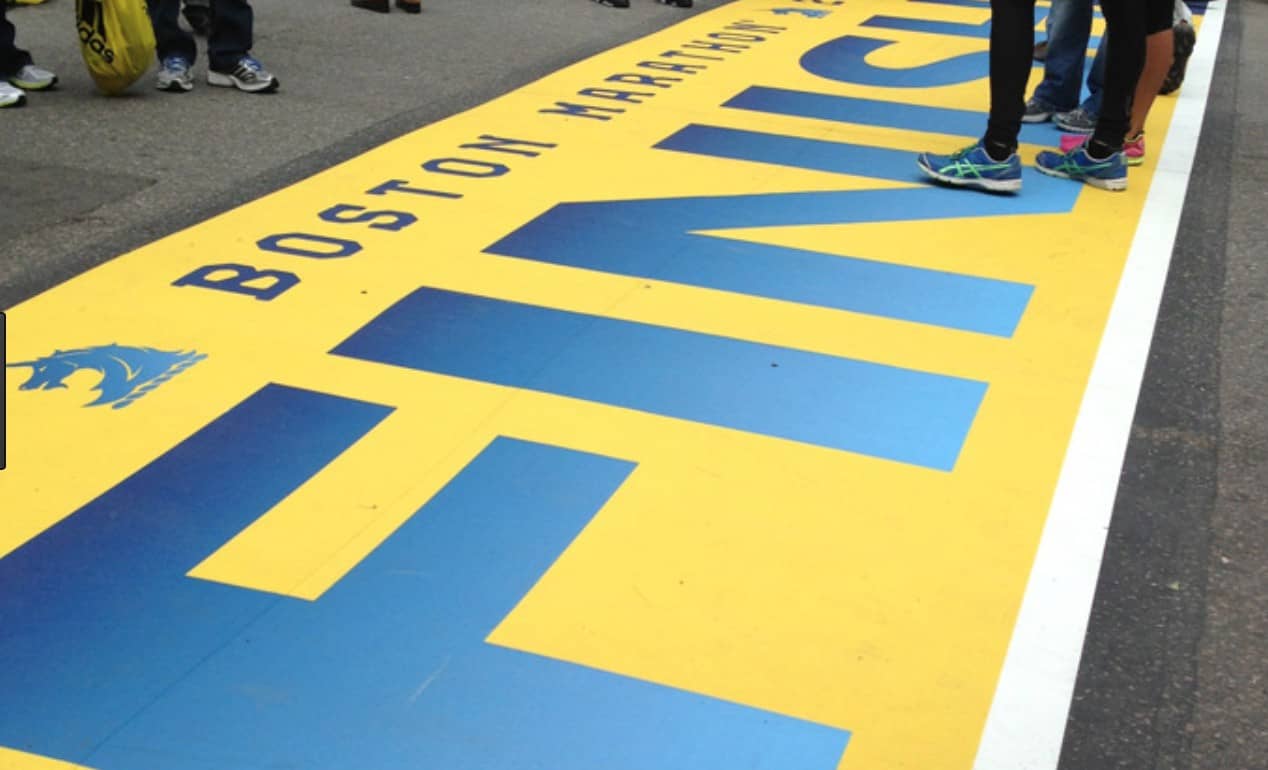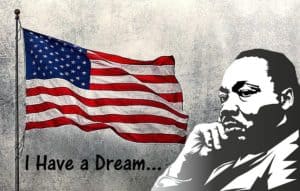 In normal times, this past Monday would have been Marathon Monday, but for the second year in a row COVID-19 meant having a large number of people travelling and gathering together on Patriots’ Day was unsafe from a public health standpoint. The Boston Marathon is one of the two athletic competitions that represent Boston sports to me; the other is the Head of the Charles Regatta in the fall. This is undoubtedly directly correlated to my status as a non-native New Englander who moved here for college. Both events were cancelled in 2020 because it was not safe to have such large numbers of athletes and spectators coming to Boston from all over the world; 30,000 runners and over 500,000 spectators for the Marathon, and 11,000 athletes in 2,000 boats with more than 200,000 spectators for the Regatta. As much as I enjoyed attending both events, after the past year of social distancing, it is almost impossible for me to imagine being in large crowds like that again.
In normal times, this past Monday would have been Marathon Monday, but for the second year in a row COVID-19 meant having a large number of people travelling and gathering together on Patriots’ Day was unsafe from a public health standpoint. The Boston Marathon is one of the two athletic competitions that represent Boston sports to me; the other is the Head of the Charles Regatta in the fall. This is undoubtedly directly correlated to my status as a non-native New Englander who moved here for college. Both events were cancelled in 2020 because it was not safe to have such large numbers of athletes and spectators coming to Boston from all over the world; 30,000 runners and over 500,000 spectators for the Marathon, and 11,000 athletes in 2,000 boats with more than 200,000 spectators for the Regatta. As much as I enjoyed attending both events, after the past year of social distancing, it is almost impossible for me to imagine being in large crowds like that again.
I haven’t been a spectator at either very often since my college years but I was a regular at both during my undergraduate and library school years. During my four years in college, the marathon route ran behind my dormitory. The Wellesley scream tunnel began in 1897 when the first Boston Marathon was held. The halfway point of the marathon is slightly past campus in downtown Wellesley. When I was a student, it was possible to run without qualifying as a “bandit,” so there were always a few runners who I knew from class or the dorm who would run the half. It was exciting to cheer them on but also fun to support runners we didn’t know. While we enjoyed seeing the elite runners, cheering for the regular runners was the real focus. During library school I watched in Kenmore Square which was a much different experience. Until the influx of Red Sox fans after the game ended, there were fewer spectators than I expected, and that close to the finish line runners showed many signs of the physical and mental toll of running 26 miles.
Once I was out of school and part of the working world, my employer did not include Patriots’ Day in its holiday list and for various reasons I never took the day off. However, commuting on Marathon Monday, first on the Green Line and then on the commuter rail, I was always amazed by the number of runners who took public transit back to their hotel or home after running a marathon! And seeing runners and spectators on the train gave me some sense of the day’s excitement. After the bombing in 2013, I decided to be a spectator again the following year. So, in 2014 I took the day off and headed to Wellesley; it was a great experience and I vowed to do it again. Life intervened and I didn’t go as often as I’d hoped, but I was planning to go in 2020. I was also looking forward to a program the library had planned for April 2020 with Paul Clerici. He is a runner and journalist who has written several books about the marathon, including Boston Marathon: History by the Mile and Boston Marathon from the Images of America series. Then March happened. Fortunately, we were able to reschedule Clerici’s presentation via Zoom in August of 2020; it is available on our YouTube channel. Tom Derderian is another marathoner who has written several books including The Boston Marathon: a Century of Blood, Sweat, and Cheers, and Boston Marathon: Year by Year Stories of the World’s Premier Running Event. All of these books and Clerici’s presentation brought back fond memories of cheering for the runners.
Bostonians have been rowing competitively on the Charles River since the mid-1800s. The Head of the Charles Regatta was first held in 1965 and has become a major feature on the competitive rowing schedule. It is a three-mile course on the Charles River and as a head race it is a race against the clock rather than direct competition against other athletes. Competitors are primarily collegiate, club, and high school teams. Although I’ve been to the Regatta several times and my best friend took up rowing in graduate school, until I read The Boys in the Boat: Nine Americans and Their Epic Quest for Gold at the 1936 Berlin Olympics, by Daniel James Brown I didn’t know much about the sport other than it required getting up very early, and rowers practice on something called an “erg” in the winter. In preparation for writing this article I requested some more books from the Minuteman catalog and found two I really enjoyed: The Wonder Crew: the Untold Story of a Coach, Navy Rowing, and Olympic Immortality, by Susan Saint Sing, and A History of Collegiate Rowing in America, by Daniella K. Garran. Both authors rowed competitively in college so they bring an insider’s perspective to their work. The Wonder Crew is about the 1920 U.S. Olympic Gold medal team which was also the U.S. Naval Academy’s collegiate team coached by Cape Cod native Richard Glendon.
Professional, college, and high school sports have found ways to come back since the pandemic closed everything down in March 2020, and many youth league sports are being held again. However, these two world-renowned sporting events have not been held. The Boston Marathon is one of the six World Marathon Majors and the oldest annual marathon. Of the six, only Tokyo was held in 2020. However, due to the pandemic its March 1 race was only open to elite runners with other runners offered a deferment. Understandably, marathons and other road races have not been able to resume since it would be difficult for participants to social distance. At the same time, running has become more popular as people find ways to exercise outside of a gym, find they have more time to exercise while not commuting, or try to tackle some pandemic weight gain.
As of the time this article was written, the Boston Athletic Association is planning for an October 11, 2021 Boston Marathon if public health conditions and local guidelines allow it, with a field of 20,000 runners plus a field of 70,000 virtual runners; there is no qualification requirement for virtual runners. The Head of the Charles Regatta is scheduled for October 23-24, 2021. I’m sure the events will be different for the competitors, particularly the marathon where runners are crowded together, and spectator rules for both events will undoubtedly be quite different this year.
Victoria Andrilenas is a Reference Librarian at the Morrill Memorial Library in Norwood, MA. Look for her article in the April 22, 2021 issue of the Transcript and Bulletin.



